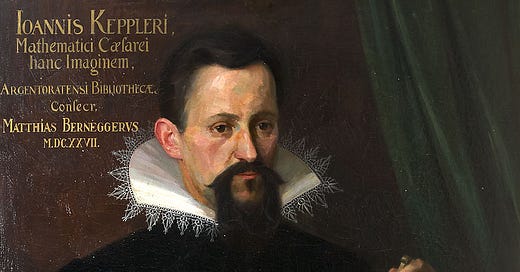I have written a number of posts about Johannes Kepler (1571-1630), and might still have some more to write. I was having difficulty keeping track of my own writings, and have therefore prepared a summary thereof, which I have organized into different categories. As I write more, I will add more entries to this post.
One of my very first blog posts was a presentation of praise for Kepler written by Arthur Koestler (1905-1983) in his The Sleepwalkers. Therein, Koestler uses quotations from Shakespeare’s King Lear and The Merchant of Venice to compare the very difficult life that Kepler lived with his grandiose vision of the cosmos.
Kepler was, as far as I know, the first to express an intuition of gravity, i.e., that two bodies, no matter their size, mutually attract each other, and that every part of the first body attracts every part of the second body, and that the mutual attraction of the two bodies is the result of the mutual attraction of their respective parts.
I came across an amusing automatic translation of Kepler from Latin to English, where the “fixed stars” became “bananas”.
Throughout his life, Johannes Kepler rejected the idea of an infinite universe, and refused to accept the idea that the new telescopes of the time allowed the viewing of celestial objects that were further away than the known stars.
Kepler’s Mysterium Cosmographicum [The Mystery of the Cosmos] (1596, revised 1621) is his first major work on astronomy. Therein he proposes a polyhedral model of the solar system to explain the placing of the orbits of the six planets known at the time.
The first inverse-square law was proposed by Kepler in 1604 in his Astronomiae pars optica [The optical part of astronomy] for the dispersion of light. It was Ismaël Boulliau (1605-1694) who first proposed in 1645 an inverse-square law for gravity.
The Astronomia Nova [New Astronomy] (1609) is where Kepler presents what are known as his first two laws, which are still studied today. The physical explanations offered by Kepler are another story…
Kepler’s Third Law is presented in his Harmonices Mundi [The Harmony of the World] (1619). He had worked for years to figure it out. He had first proposed in Mysterium Cosmographicum that the times of the orbits of two planets were in relation to their radii. Then he proposed in Astronomia Nova that the times of two orbits were in relation to the squares of their radii. Finally, he correctly proposed in Harmonices Mundi that the squares of the times of two orbits were in relation to the cubes of their radii.
If you wish to donate to support my work, please use the Buy Me a Coffee app.




